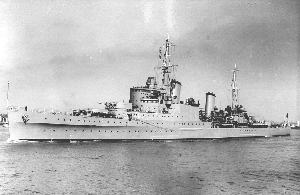HMS Glasgow (C21)
 |
|
| History | |
|---|---|
|
|
|
| Name: | HMS Glasgow |
| Builder: | Scotts Shipbuilding and Engineering Company, Greenock |
| Laid down: | 16 April 1935 |
| Launched: | 20 June 1936 |
| Commissioned: | 9 September 1937 |
| Decommissioned: | November 1956 |
| Identification: | Pennant number: C21 |
| Fate: | Sold for scrap, July 1958 |
| General characteristics | |
| Class and type: | Town-class light cruiser |
| Displacement: |
|
| Length: | 558 ft (170 m) |
| Beam: | 61 ft 8 in (18.80 m) |
| Draught: | 21 ft 6 in (6.55 m) |
| Propulsion: |
|
| Speed: | 32 knots (59 km/h) |
| Complement: | 748 |
| Armament: |
|
| Aircraft carried: | Two Supermarine Walrus aircraft (Removed in the latter part of WWII) |
The seventh HMS Glasgow, built on the Clyde, was a Southampton-class light cruiser, a sub-class of the Town-class and commissioned in September 1937. She displaced 11,930 tons and had a top speed of 32 knots (59 km/h). She was part of the 2nd Cruiser Squadron of the Home Fleet; she escorted the King and Queen to Canada in 1939. She also took a large quantity of gold to Fort Knox as an emergency reserve.
Captain Frank Pegram was commanding officer of Glasgow from July, 1939 to April, 1940. On the outbreak of war, she operated off the Scandinavian coast, and in November was off the coast of Norway with two destroyers in the hope of intercepting the German passenger ship SS Bremen which had sailed from Murmansk. This was unsuccessful, but on 12 February 1940, she captured the German trawler Herrlichkeit off Tromsø. On 9 April, she was attacked off Bergen by Ju 88s and He 111s and damaged by near misses. On 11 April 1940, during the Allied campaign in Norway in World War II, Glasgow, along with HMS Sheffield and six Tribal-class destroyers landed troops near Harstad and three days later on 14 April, again in company with Sheffield and ten destroyers, landed an advance force of Royal Marines at Namsos to seize and secure the wharves and approaches to the town, preparatory to the landing of a larger Allied force. On 23 April Glasgow, Sheffield, HMS Galatea and six destroyers landed the first part of the 15th Infantry Brigade in Åndalsnes.
...
Wikipedia
